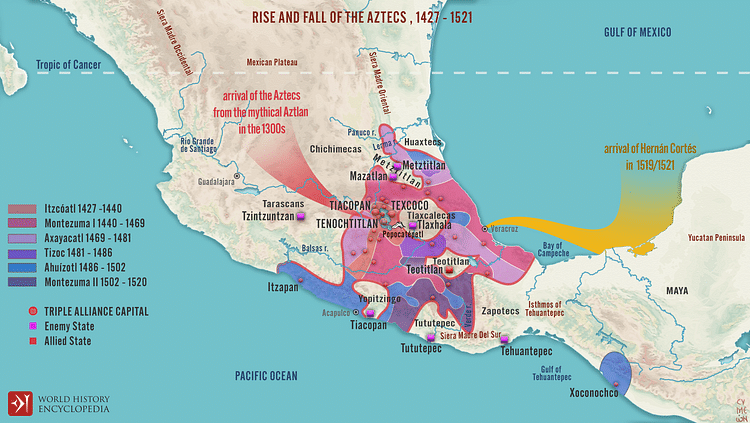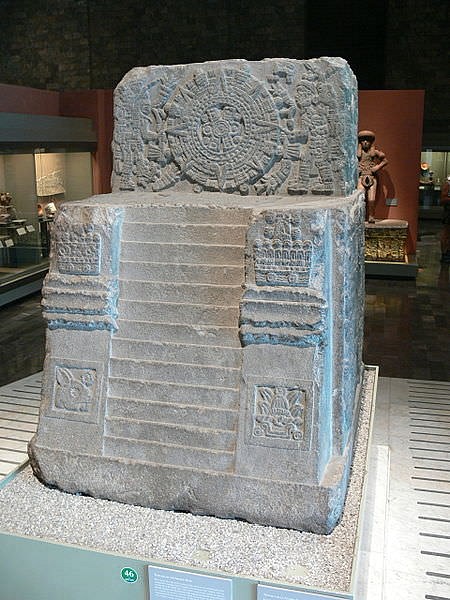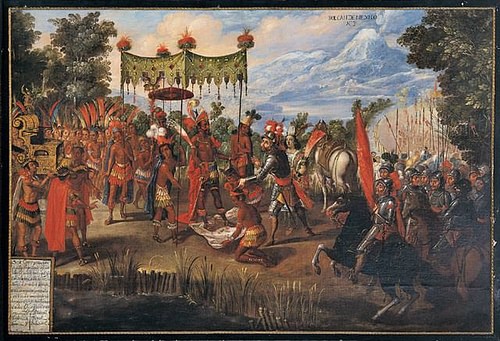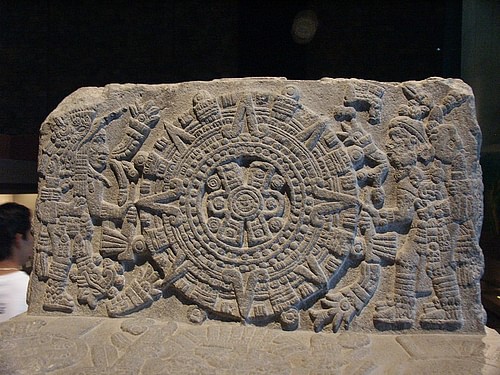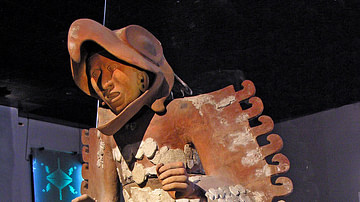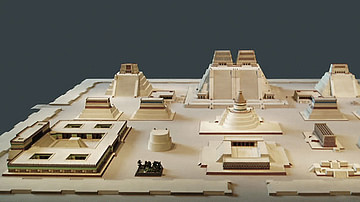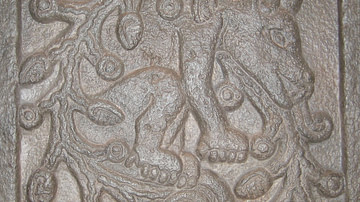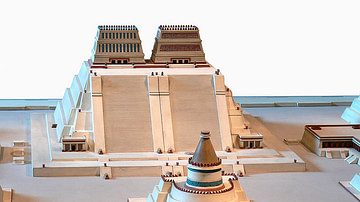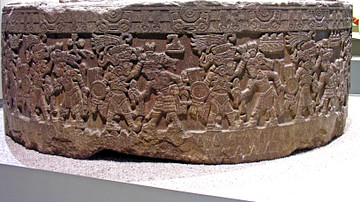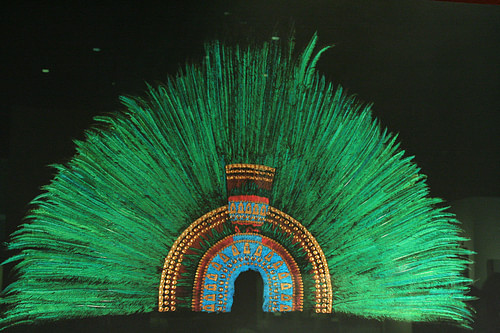
Montezuma (aka Moctezuma), or more correctly, Motecuhzoma II Xocoyotzin, meaning 'Angry Like A Lord’, was the last fully independent ruler of the Aztec empire before the civilization's collapse after the Spanish Conquest in the early 16th century CE. Taking the position of tlatoani, meaning 'speaker', in 1502 CE he ruled as an absolute monarch until 1520 CE.
During his reign, Motecuhzoma expanded the Aztec empire and was considered a god by his people, literally a manifestation and perpetuator of the sun. The ruler famously lived in a huge palace at the Aztec capital of Tenochtitlan which boasted magnificent hanging gardens and even a zoo.
An Absolute Ruler
Motecuhzoma was the son of the great leader Axayacatl (r. 1469-1481 CE) and was one of the best warriors under his uncle Ahuitzotl (r. 1486-1502 CE). In particular, he distinguished himself in the Aztec campaigns in Tehuantepec and Xoconochco. On the death of Ahuitzotl, Motecuhzoma assumed the highest position in Aztec society and he became, in a sumptuous coronation ceremony, the undisputed religious and political leader or tlatoani in 1502 CE.
We are fortunate to have a first-hand physical description of Motecuhzoma by Bernal Diaz del Castillo, who saw him in 1519 CE:
[He was] about 40 years old, of good height and well-proportioned, slender and spare of flesh, not very swarthy, but of the natural colour and shade of an Indian. He did not wear his hair long, but so as just to cover his ears, his scanty black beard was well-shaped and thin. His face was somewhat long, but cheerful, and he had good eyes and showed in his appearance and manner both tenderness and, when necessary, gravity. (Townsend, 19)
As part of the ceremonies to confirm him in his new status Motecuhzoma led an army, in what became known as the Coronation War, to Nopallan, 640 km to the south. Conquering the fortified city he brought back to Tenochtitlan substantial booty and a contingent of captives for ritual sacrifice. The new tlatoani was also commemorated in a specially commissioned stone (now known as the Coronation Stone of Motecuhzoma II) which was covered in carvings depicting the five eras of Aztec mythology, the year sign 11-reed (1503 CE) and the day 'one alligator' (4th of June).
Motecuhzoma set about widening the powers of the tlatoani position by simultaneously reducing the duties of the chief of internal affairs (Tlacaellel or Cihuacoatl) so that he became, in effect, absolute ruler and undisputed leader of the Triple Alliance of the three great cities of Tenochtitlan, Tetzcoco and Tlacopan. Motecuhzoma also elevated the status of the nobility by further differentiating them from the rest of society through an increased emphasis on titles, distinguishing clothes and insignia and etiquette at court.
Motecuhzoma commanded, then, an empire which stretched from the northern limits of Mexico to today's Guatemala. Indeed, he even expanded it and fought four major wars so that only the Tarascans in the east and the Tlaxcalans in the west remained unconquered. These subject states all paid tribute as indicated in the Aztec tax records. Tribute could take the form of traditional precious materials such as gold and jade, exotic feathers and even animals such as eagles and jaguars. Tribute could also be in the form of clothes, fabrics and foodstuffs such as corn and cacao.
A Life of Luxury
Motecuhzoma certainly lived like a king. His huge palace at the Aztec capital of Tenochtitlan had hanging gardens, a ten-room aviary with fresh and salt-water pools, and even a private zoo with jaguars, eagles, pumas, foxes and snakes amongst hundreds of other exotic animals. The Aztec king was cared for by 3,000 attendants and, according to Bernal Diáz, a typical royal meal included hundreds of specially made dishes which included turkey, venison, duck, pigeon, rabbit, quail, fish and boar, all served on finely decorated and especially delicate Cholula pottery. We are also told that the king ate alone and behind a gilded screen, entertained by jugglers and acrobats.
Other snippets of information about the ill-fated king include the fact that he visited the great city of Teotihuacan several times, a pilgrimage that entailed the crossing of Lake Texcoco by canoe. That he had a fascination for dwarves, hunchbacks and albinos, all of which were kept in special chambers within the royal palace and we also know that he wore golden sandals and loved to hunt birds using a blowpipe. Finally, he was interested in the arts, astrology and philosophy.
The Beginning of the End
Even before the Spanish arrived, all was not quite well with the Aztecs for their empire was based not on military might but existed as a loose binding of subject states run by puppet rulers who extracted the tributes mentioned above and imposed the worship of the Aztec deity Huitzilopochtli. The Aztecs, though, perhaps over-reached themselves and several outer tribes began to rebel, especially following the disastrous defeat in 1515 CE to the Tlaxcala and Huexotzingo. These insurrections against Aztec rule were quashed but trouble was never far below the surface and, perhaps most significantly, the harsh treatment of the Tlaxcala would later make them more than willing allies of the Spanish.
Motecuhzoma seems to have had some instinct that troubled times were ahead as he gave great importance to omens such as a comet sighted in 1509 CE and he constantly consulted soothsayers for advice. Aztec mythology foretold that the present era of the 5th sun would eventually collapse just as the previous four eras had done. By 1515 CE rumours of a rapidly approaching crisis were fuelled by sightings off the coast of fantastic floating temples; the visitors from the Old World had finally come.
The Aztec leader's first strategy with the strange visitors from another world was to attempt to buy them off with gifts. These included ceremonial costumes, a massive gold disk representing the sun and an even bigger silver one representing the moon. However, if anything, this may well have further encouraged the Spanish to plunder this new land for all it was worth.
In August 1519 CE the leader of the Spanish Conquistadors Hernán Cortés marched on Tenochtitlan. According to the Spanish sources, the Aztec emperor allowed them entry to the city. From here on in the history of the conflict is much debated amongst scholars and it is unlikely that the Spanish chroniclers presented a completely impartial account of events. It has been noted that it does seem strange that such a powerful ruler as Motecuhzoma should cut such a passive figure in the record of events brought down to us. However, against that it is certainly true that the Spanish had shown their military prowess and the devastating effectiveness of their superior weaponry - canons, firearms and crossbows - in quickly defeating a force of Otomi-Tlaxcalan and they also took quick and ruthless reprisals against a treacherous plot by the Cholollan. Perhaps Motecuhzoma had taken note of this and took the more prudent policy of appeasement rather than engage the enemy in the field, at least as an opening strategy.
When Cortés and Motecuhzoma finally met in person relations were initially amiable, the Spaniard was given a tour of the city and more gifts were exchanged, Cortés receiving a necklace of golden crabs and Motecuhzoma a necklace of Venetian glass strung on gold thread. Whatever Motecuhzoma had hoped to achieve through diplomacy his plans were scuppered in just two weeks when he was promptly taken hostage and placed under house arrest by the small Spanish force. Motecuhzoma was forced to declare himself a subject of Charles V, handover more treasure and even allow the placing of a crucifix on top of the Great Pyramid in the city's sacred precinct.
Cortés' plans met with a setback, however, when he was forced to return to his base at Veracruz to face a rival Spanish faction. In his absence the remaining Spanish unwisely disrupted a religious ceremony involving human sacrifice and fighting broke out. The Aztec warriors, seething at the lack of decisive action renounced Motecuhzoma as their leader and Cuitlahuac was voted in as the new tlatoani. Motecuhzoma was pressed by the Spanish into pacifying his people but was struck on the head by a rock and killed.
Cortés returned to the city to relieve the besieged remaining Spanish but was forced to withdraw on the 30th June 1520 CE in what became known as the Noche Triste. He did, however, return nine months later, this time with his Tlaxcalan allies and, after a lengthy siege, the city finally fell. The Aztecs, led by Cuauhtemoc and ravaged by lack of food and disease, finally collapsed on the fateful day of 13th August 1521 CE. Tenochtitlán was ransacked of any precious goods and its monuments were destroyed. From the ashes rose the new capital of the colony of New Spain and the long line of Mesoamerican civilizations which had stretched right back to the Olmec came to a dramatic and brutal end.
Motecuhzoma in Art
Motecuhzoma is represented in the Histories of the Indies by Dominican Diego Durán where he is seated as a statue is carved of him. We know of one particular statue which 14 sculptors worked on at Chapultepec. The Aztec ruler also appears on the stone throne known as the Teocalli Stone where he appears with a sun-disk opposite Huitzilopochtli. Also attributed to Motecuhzoma, although there is no concrete evidence to do so, is the magnificent feather headdress now in the Museum für Völkerkunde of Vienna. The headdress was probably part of the collection of artefacts given by Motecuhzoma to Cortés who passed on the gifts to Charles V. The headdress is made from 450 green quetzal, blue cotinga and pink flamingo feathers and is further embellished with gold beads and jade disks.
